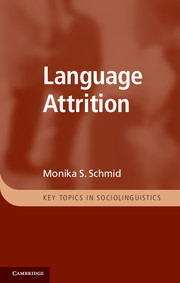Book contents
- Frontmatter
- Contents
- List of figures
- List of tables
- Preface
- Abbreviations
- 1 Introduction
- Part I Linguistic aspects of language attrition
- Part II Extralinguistic aspects of language attrition
- 6 Personal background factors
- 7 The role of L1 input and output
- 8 Attitudes and identities
- Part III Conducting research on language attrition – preliminary considerations
- Part IV Experimental designs for attrition research – the language attrition test battery
- Part V Coding and analysing the data
- 18 Conclusion
- Glossary
- Notes
- References
- Index
7 - The role of L1 input and output
Published online by Cambridge University Press: 05 June 2012
- Frontmatter
- Contents
- List of figures
- List of tables
- Preface
- Abbreviations
- 1 Introduction
- Part I Linguistic aspects of language attrition
- Part II Extralinguistic aspects of language attrition
- 6 Personal background factors
- 7 The role of L1 input and output
- 8 Attitudes and identities
- Part III Conducting research on language attrition – preliminary considerations
- Part IV Experimental designs for attrition research – the language attrition test battery
- Part V Coding and analysing the data
- 18 Conclusion
- Glossary
- Notes
- References
- Index
Summary
Does it help prevent L1 attrition if you go on using the language on a regular basis? What kinds of language use are necessary? This chapter will explore how L1 use relates to L1 attrition.
Cast your mind back to some of the differences between the excerpt from the narratives of Gertrud U. and Albert L. In part I above, I pointed out that they were different from each other on a range of features (see Table 7.1).
When you see this kind of difference between two speakers who have lived in emigration for more or less the same number of years, the first intuition about how these differences came about is likely to be that Albert L. had probably had more opportunities to ‘practise’ his German over the years than Gertrud U.
It is an apparently reasonable and natural assumption that speakers who continue to use a language remain fluent in it while speakers who don't forget it. Human knowledge and memory need to be maintained to prevent them from deteriorating: the more often knowledge is called upon, the easier it becomes to recall. If, on the other hand, a certain memory is not activated for a long time, it will eventually become difficult to retrieve.
- Type
- Chapter
- Information
- Language Attrition , pp. 81 - 95Publisher: Cambridge University PressPrint publication year: 2011
- 1
- Cited by



